Is there anything more agreeable than settling into an almost-empty train carriage on a sunny Saturday morning with a fresh Telegraph crossword and the bucolic English countryside sliding past the window and an interesting destination ahead and another pleasing train ride home to look forward to at the end of the day? Well probably, but for the moment that will suffice. London may be a magnificent city and an exciting place to live, and also be absolutely chock full of interesting sights, but sometimes it’s nice to get out. Therefore, I’m pleased to present the first in what I hope will be a recurring series of posts about sights that are an easy trip out of London for those days when the big city is just a bit too much. First up: Bletchley Park.
Bletchley Park is an estate in the town of Bletchley, located just outside of the much-maligned city of Milton Keynes, a pleasant train journey to the northwest of London. It’s famous and interesting because it was the site of the UK’s main World War II code-breaking efforts and home to the Government Code and Cypher School. (No, that not a typo. That’s how they spelled cipher back then.) Bletchley Park, or, more accurately, those who worked at Bletchley Park, are best know for cracking the codes encrypted by the German Enigma and Lorenz machines, leading to intelligence breakthroughs that Churchill claimed shortened the war by as much as two years.
Bletchley was staffed with some of the finest minds in the country, drawn from Oxford and Cambridge (both easily accessible by train) and also found by other more interesting means, my favourite of which is this: In 1941 “the ability to solve a Daily Telegraph crossword in under 12 minutes was used as a test. The newspaper was asked to organize a competition, after which each of the successful participants was contacted and asked whether they would be prepared to undertake ‘a particular type of work as a contribution to the war effort’. The competition was won by F H W Hawes of Dagenham, who finished in less than eight minutes.” (Wikipedia) Clearly, this was my kind of place (though if I ever manage to complete a Telegraph crossword in eight, or even twelve minutes, you’ll be hearing about it on CNN).
Most people go to Bletchley Park to see the Enigma machines and learn about how the code was broken, and here we will get into a bit of technical stuff because I think it’s cool and interesting, and it’s my blog, so settle in.
Here’s how Enigma works: When you press a key on the keyboard, like J, it completes an electrical circuit. The current passes from the J on the keyboard to a plug board where J might be patched into Q. From the Q of the plugboard the current goes to the first of three rotors. Each rotor is hardwired so that current entering as one letter passes out again as a different letter. So the current might enter the first rotor as Q and exit as H. It enters the second rotor and H and comes out as E then enters the third rotor as E and comes out as P. Then the current is reflected back through all the rotors again, changing the letter three more times before it then lights up a letter on the indicator board. Thus the initial key press is changed seven times before reaching its final encrypted state. Also, every time a key is pressed, the first rotor rotates one stop. When it completes a revolution (26 stops) the next rotor moves as well. And when the second rotor completes a revolution the third rotor also moves. This means that the code changes with every letter. Tricky!
To further complicate matters, German operators were instructed to change the settings of the machine every day to confound code-breakers. Though only three (and later four) rotors were used in the machine, it came equipped with five. Thus the operator had to be told which three rotors to use, the order in which to use them, and the position in which to start each wheel. Finally, the patch cables on the plug board would also be switched. However, if a sender and receiver set up their machines in the same way a text could be encrypted, sent over the radio with Morse Code, and then the encrypted text typed into an identically configured machine, thus revealing the message.
Even though the Allies had captured and recreated Enigma machines, they could not begin to decipher the enemy messages without knowing the settings for each type of machine each day. A properly configured 3-rotor Enigma machine can create 158 million million million different combinations of settings, so clearly the brute force approach was a non-starter. This is where the code breakers enter the picture. What eventually scuppered the German Enigma machine was a combination of a simple quirk in the machine’s design and, not surprisingly, human error.
The quirk was this: Enigma could never encode a letter as itself. The human error part is this: the Germans encoded everything. Not just top secret troop movements and such, but every bit of radio traffic they sent, including mundane things like weather reports. This meant that is the allies got hold of a message they knew came from a weather station in Rome, they could be reasonably sure that somewhere very near the beginning of the message would be the phrase “weather report for Rome”. Sure enough, this was the case, and by taking that known phrase and comparing it to the cipher text, while bearing in mind that no letter could be encrypted as itself, they were able to make an educated guess about how the message was encrypted. This guess, called a “crib”, was then fed into an enormous machine called a Bombe.
The Bombe was designed by Alan Turing, the brilliant mathematician and famous code breaker. The machine is an electromechanical device used to test possible rotor settings, based on the educated guesses from those “cribs”. Though all existing bombe were ordered destroyed at the end of the war, in true British boffin fashion, a group of amateur enthusiasts have recreated a complete working Bombe which is on display at Bletchley Park, and I was there on a day when they actually had the thing fired up and running. It’s huge - about 8’ wide x 6 high x 2’ deep, and it’s all spinning, clicking, clunking stuff, coupled with about 47 miles of wiring and relays and resistors and such in the back. I have no idea how it worked but it must have, because at one point there were about 200 of them in operation at different sites around the UK, and they managed to crack the codes fast enough to make a huge difference in the war.
This makes it sound a bit like it was simply a matter of scanning an incoming message, flipping a few switches and Hey Presto, there was the message, all neatly deciphered: “Send more sauerbrauten. Supplies low.” In fact it was hugely labour-intensive. First, the messages had to be recorded at Wireless Intercept Stations all over the country (where they had likely been copied by two or three woman at the same time to ensure accuracy). Then the messages were sent by motorcycle courier (also women) to Bletchley Park where they went to the codebreakers for the “crib hunt” which resulted in the method to program the Bombes. This programming (also done mostly by women) took the form of re-plugging the cables behind the machine and was not a speedy process. Then the Bombe was started and each time it spit out a potential solution that had to be fed into a separate checking machine. Sometimes a whole day would pass and no solution would be found. However, when correct Enigma settings were discovered a British-made Enigma-like machine could be set up to decipher all the days messages that corresponded to those settings (and each branch of the German military used different machines and different settings). Like I said, labour-intensive. At the height of the war there were as many as 9,000 people working at Bletchley Park, and the volume of messages that passed through was staggering – 2,000 on an average day, but during the D-Day landings they handled 18,000 messages in one day!
So Bletchley Park is all about the code breakers and Enigma Machines and the Bombes and all that. There are displays of the different machines and explanations of all the procedures and such, which you will now never have to read because you made it this far in the blog post. There are also lots of displays relating to the war itself, most of which are housed in the actual wooden huts that once were home to the code breakers, though many are in a sad state.
But Bletchley Park is also bizarrely crammed with about a zillion other things to divert your attention, some of which are appropriate to the era and subject matter, some of which are linked rather tenuously, and some of which I suspect are just there to pay a bit of rent and help keep the doors open.
There are displays about life at Bletchley Park in particular and about life during war time in general. I liked those bits, including lots of posters about rationing and morale and such.
There’s also the estate mansion itself to see, though much of it is closed to the public.
And there is a garage of old cars…
… and a museum of old toys and games…
… and a tiny Post Office…
… and the National Museum of Computing (including the first ever programmable computer, called “Colosuss” developed to break the twelve-rotor Lorenz cipher)…
But there was one unlikely display that kept me transfixed even more than the Enigma machines. To paraphrase the bard: “Cry havoc and let slip the pigeons of war!”
Tucked away in a side room in Hut 8 was a display about the National Pigeon Service. Yep. Pigeons. Who who knew that homing pigeons were the unsung heroes WWII? (Shut up you did not. You're just showing off.) The homing pigeon’s amazing ability to return to its loft even when released hundreds of miles away in unfamiliar territory meant that more than a quarter of a million pigeons were used to carry messages for the Allies in the war. Some were parachuted in canisters behind enemy lines to resistance workers, who could then send reports back to England.
All RAF bombers carried pigeons in water-tight containers so that if they had to ditch at sea the bird could be released with a message containing the approximate position of the wreck, thus making rescue much more likely. Thousands of servicemen were saved in this way. Pigeons were so useful that both sides used them extensively and anyone in Germany caught with an unregistered pigeon was executed. British pigeons were recruited from the best breeders all over the country, including the Royal lofts at Sandringham. Some breeders were instructed to put their best birds in unmarked boxes and leave them at an appointed hour at St. James’s Park tube station, where they were retrieved by government pigeon operatives. The secret pigeon service was called MI 14. (I am not kidding. There’s MI 5, there’s MI 6. And there is, or at least there was, MI 14, the secret pigeon service.)
Remarkably, 32 homing pigeons were even awarded the Dickin Medal, commonly referred to as the “Animal Victoria Cross”. One recipient was Mary of Essex, a pigeon who was attacked by a falcon during a mission, but still returned to deliver her message. She was deemed so valuable to the war effort that her owner was instructed to stitch her up and get her back in the air. After her 22 stitches healed she returned to work, survived several other falcon attacks, and never failed to complete a mission. (TWENTY-TWO stitches? IN A PIGEON? Is a pigeon even 22 stitches long?) Mary of Essex died of old age and is buried in an animal cemetery.
Peregrine falcons were used by the Germans to intercept and kill British pigeons. And the British eventually trained falcons to capture German homing pigeons without killing them, thus intercepting their messages. The British even managed to drop “double agent” pigeons behind enemy lines who were unknowingly adopted by German pigeon handlers but promptly returned to their British lofts when released, thus delivering their German messages into Allied hands. I’m telling you, these pigeons rocked my world.
Finally, I have to tell you about the remarkably fitting end to my day. I took a few well-needed breaks during my day at Bletchley Park, because you really have to when tackling a site like that. And on my breaks I worked on the Daily Telegraph Saturday Prize Crossword which felt very fitting given the day’s theme. I made good progress on the puzzle (half-way mark reached at 2:01pm) and had it almost finished by the time the train pulled in at Euston. Then, with one or two clues left, I finally cracked it on the tube on the way home to Brixton, which pasted such a goofy smile on my face that people in adjacent seats edged away from me. It was the fist time I’ve ever completed a Saturday puzzle, and it felt like the ghosts of Bletchley Park must have been with me. Then, when I got home, I pulled out the “52 page Ultimate Puzzle Book” that just happened to be a special inclusion with the day’s paper, and which I’d lugged around all day. And what did it say along the bottom of the front cover? “Crosswords. Logic. Sudoku. Visual. Numbers. PLUS BLETCHLEY PARK CODEBREAKERS” I’m not kidding, there was a whole section in the book about Bletchley Park and code breaking. And best of all, they reprinted that 1941 crossword that was used to recruit potential codebreakers. So my whole day hung together perfectly, like a good crossword clue. And you can’t ask for better than that.
P.S. Total cost of this Day Out: Picnic lunch (including treats) from Sainsbury’s: £3.49, freakishly appropriate Saturday Telegraph: £2,20, Same Day Return Off Peak train ticket from Euston Station: £14.00, Admission: £12.00 (valid for one year), coffee from the canteen: £1.70, coffee for the train home: £2.20. Total: £35.59. Not exactly cheap, but really not bad.
P.P.S. All my pics from the day are in the Bletchley Park Set, at Flickr.
Bletchley Park is an estate in the town of Bletchley, located just outside of the much-maligned city of Milton Keynes, a pleasant train journey to the northwest of London. It’s famous and interesting because it was the site of the UK’s main World War II code-breaking efforts and home to the Government Code and Cypher School. (No, that not a typo. That’s how they spelled cipher back then.) Bletchley Park, or, more accurately, those who worked at Bletchley Park, are best know for cracking the codes encrypted by the German Enigma and Lorenz machines, leading to intelligence breakthroughs that Churchill claimed shortened the war by as much as two years.
Bletchley was staffed with some of the finest minds in the country, drawn from Oxford and Cambridge (both easily accessible by train) and also found by other more interesting means, my favourite of which is this: In 1941 “the ability to solve a Daily Telegraph crossword in under 12 minutes was used as a test. The newspaper was asked to organize a competition, after which each of the successful participants was contacted and asked whether they would be prepared to undertake ‘a particular type of work as a contribution to the war effort’. The competition was won by F H W Hawes of Dagenham, who finished in less than eight minutes.” (Wikipedia) Clearly, this was my kind of place (though if I ever manage to complete a Telegraph crossword in eight, or even twelve minutes, you’ll be hearing about it on CNN).
Most people go to Bletchley Park to see the Enigma machines and learn about how the code was broken, and here we will get into a bit of technical stuff because I think it’s cool and interesting, and it’s my blog, so settle in.
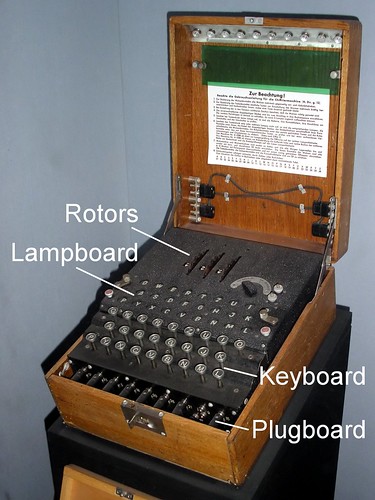 |
| There were many versions of the device, but a typical Engima machine looks like this. |
To further complicate matters, German operators were instructed to change the settings of the machine every day to confound code-breakers. Though only three (and later four) rotors were used in the machine, it came equipped with five. Thus the operator had to be told which three rotors to use, the order in which to use them, and the position in which to start each wheel. Finally, the patch cables on the plug board would also be switched. However, if a sender and receiver set up their machines in the same way a text could be encrypted, sent over the radio with Morse Code, and then the encrypted text typed into an identically configured machine, thus revealing the message.
Even though the Allies had captured and recreated Enigma machines, they could not begin to decipher the enemy messages without knowing the settings for each type of machine each day. A properly configured 3-rotor Enigma machine can create 158 million million million different combinations of settings, so clearly the brute force approach was a non-starter. This is where the code breakers enter the picture. What eventually scuppered the German Enigma machine was a combination of a simple quirk in the machine’s design and, not surprisingly, human error.
The quirk was this: Enigma could never encode a letter as itself. The human error part is this: the Germans encoded everything. Not just top secret troop movements and such, but every bit of radio traffic they sent, including mundane things like weather reports. This meant that is the allies got hold of a message they knew came from a weather station in Rome, they could be reasonably sure that somewhere very near the beginning of the message would be the phrase “weather report for Rome”. Sure enough, this was the case, and by taking that known phrase and comparing it to the cipher text, while bearing in mind that no letter could be encrypted as itself, they were able to make an educated guess about how the message was encrypted. This guess, called a “crib”, was then fed into an enormous machine called a Bombe.
The Bombe was designed by Alan Turing, the brilliant mathematician and famous code breaker. The machine is an electromechanical device used to test possible rotor settings, based on the educated guesses from those “cribs”. Though all existing bombe were ordered destroyed at the end of the war, in true British boffin fashion, a group of amateur enthusiasts have recreated a complete working Bombe which is on display at Bletchley Park, and I was there on a day when they actually had the thing fired up and running. It’s huge - about 8’ wide x 6 high x 2’ deep, and it’s all spinning, clicking, clunking stuff, coupled with about 47 miles of wiring and relays and resistors and such in the back. I have no idea how it worked but it must have, because at one point there were about 200 of them in operation at different sites around the UK, and they managed to crack the codes fast enough to make a huge difference in the war.
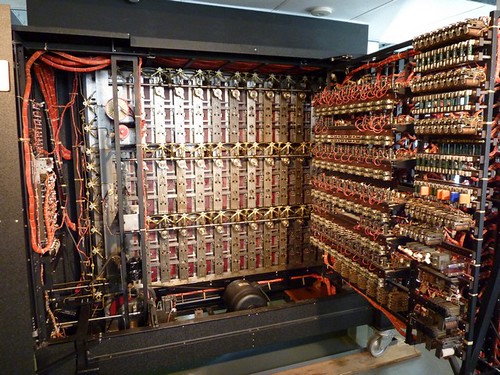 |
| The open back of the recreated Bombe. I took a video that shows it in all its whirring, clinking glory, but video is just not cooperating with me these days... |
So Bletchley Park is all about the code breakers and Enigma Machines and the Bombes and all that. There are displays of the different machines and explanations of all the procedures and such, which you will now never have to read because you made it this far in the blog post. There are also lots of displays relating to the war itself, most of which are housed in the actual wooden huts that once were home to the code breakers, though many are in a sad state.
 |
| Not in good shape at all. The brick walls used to go up above the windows to protect against bomb blasts. |
There are displays about life at Bletchley Park in particular and about life during war time in general. I liked those bits, including lots of posters about rationing and morale and such.
There’s also the estate mansion itself to see, though much of it is closed to the public.
And there is a garage of old cars…
… and a museum of old toys and games…
… and a tiny Post Office…
… and the National Museum of Computing (including the first ever programmable computer, called “Colosuss” developed to break the twelve-rotor Lorenz cipher)…
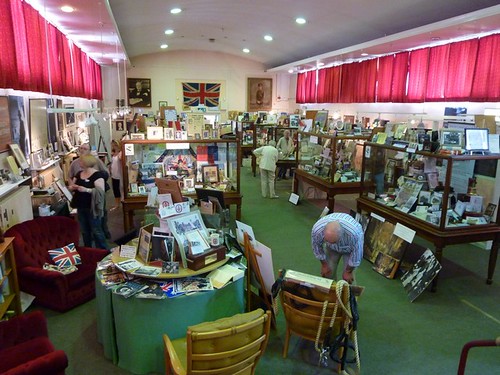 |
| Everything here was amassed by one guy. Truly, he has embraced the concept of the classic English Eccentric. |
Tucked away in a side room in Hut 8 was a display about the National Pigeon Service. Yep. Pigeons. Who who knew that homing pigeons were the unsung heroes WWII? (Shut up you did not. You're just showing off.) The homing pigeon’s amazing ability to return to its loft even when released hundreds of miles away in unfamiliar territory meant that more than a quarter of a million pigeons were used to carry messages for the Allies in the war. Some were parachuted in canisters behind enemy lines to resistance workers, who could then send reports back to England.
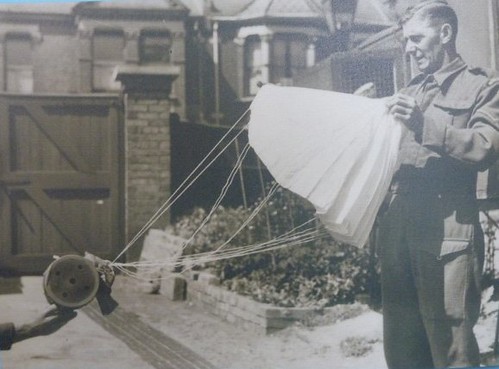 |
| Parachuting pigeon system. Presumably this was slightly off-putting for the pigeon |
Remarkably, 32 homing pigeons were even awarded the Dickin Medal, commonly referred to as the “Animal Victoria Cross”. One recipient was Mary of Essex, a pigeon who was attacked by a falcon during a mission, but still returned to deliver her message. She was deemed so valuable to the war effort that her owner was instructed to stitch her up and get her back in the air. After her 22 stitches healed she returned to work, survived several other falcon attacks, and never failed to complete a mission. (TWENTY-TWO stitches? IN A PIGEON? Is a pigeon even 22 stitches long?) Mary of Essex died of old age and is buried in an animal cemetery.
Peregrine falcons were used by the Germans to intercept and kill British pigeons. And the British eventually trained falcons to capture German homing pigeons without killing them, thus intercepting their messages. The British even managed to drop “double agent” pigeons behind enemy lines who were unknowingly adopted by German pigeon handlers but promptly returned to their British lofts when released, thus delivering their German messages into Allied hands. I’m telling you, these pigeons rocked my world.
Finally, I have to tell you about the remarkably fitting end to my day. I took a few well-needed breaks during my day at Bletchley Park, because you really have to when tackling a site like that. And on my breaks I worked on the Daily Telegraph Saturday Prize Crossword which felt very fitting given the day’s theme. I made good progress on the puzzle (half-way mark reached at 2:01pm) and had it almost finished by the time the train pulled in at Euston. Then, with one or two clues left, I finally cracked it on the tube on the way home to Brixton, which pasted such a goofy smile on my face that people in adjacent seats edged away from me. It was the fist time I’ve ever completed a Saturday puzzle, and it felt like the ghosts of Bletchley Park must have been with me. Then, when I got home, I pulled out the “52 page Ultimate Puzzle Book” that just happened to be a special inclusion with the day’s paper, and which I’d lugged around all day. And what did it say along the bottom of the front cover? “Crosswords. Logic. Sudoku. Visual. Numbers. PLUS BLETCHLEY PARK CODEBREAKERS” I’m not kidding, there was a whole section in the book about Bletchley Park and code breaking. And best of all, they reprinted that 1941 crossword that was used to recruit potential codebreakers. So my whole day hung together perfectly, like a good crossword clue. And you can’t ask for better than that.
P.S. Total cost of this Day Out: Picnic lunch (including treats) from Sainsbury’s: £3.49, freakishly appropriate Saturday Telegraph: £2,20, Same Day Return Off Peak train ticket from Euston Station: £14.00, Admission: £12.00 (valid for one year), coffee from the canteen: £1.70, coffee for the train home: £2.20. Total: £35.59. Not exactly cheap, but really not bad.
P.P.S. All my pics from the day are in the Bletchley Park Set, at Flickr.


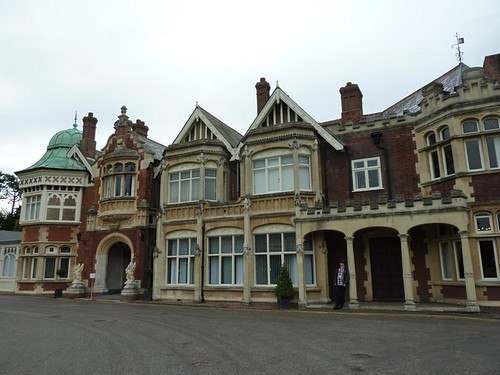
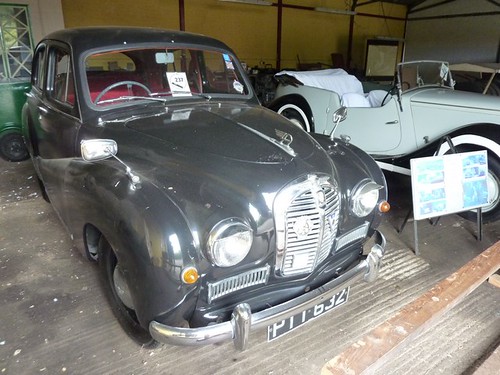
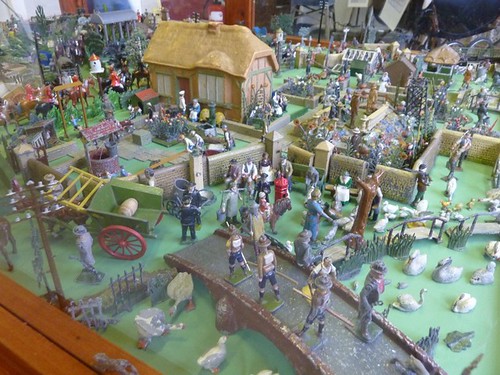
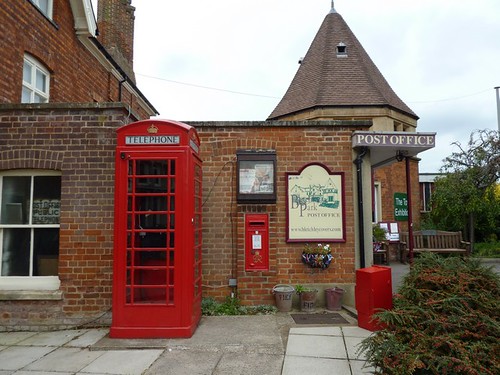
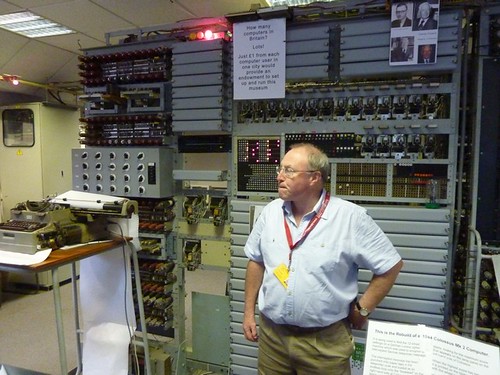


7 Comments:
I like your blogs because they have a good variety of topics, which reflects how interesting a person you are.
Technology, Art, Food, Society, Drinks, Wonderful things, Maddening things, Curious things...
Keep it up. Your London Blog seems to have found it's stride.
rh
Love today's oost- it's going in my Travel file for reference for the next trip to London. I read Enigma (fiction, tho based on facts!) a few years back and didn't realize one could go see Bletchley Park these days!
Thanks for sharing your day and all the good information - and congrats on your crossword success!
d;)
Great post! Have you gone to the Churchill War Rooms?
Okay, Pam. What was your time on the 1941 recruiting puzzle??
Am enjoying your commentaries and hope that your working/biking/running are all going well.
Take care, ck
LOVE this post Pam! So interesting. Glad you had such a good day out.
Do you still have the 1941 crossword puzzle? I am a BP guide trying to source a copy.
In case you didn't get my email address, it is joelmg6@gmail.com. As with most bloggers, I suspect only you see comments on old posts - so putting my email address here is probably ok. I have colleagues at Cambridge who are very keen to get a copy of the crossword puzzle as part of their contribution to the Turing Centenary next year. Joel
Post a Comment